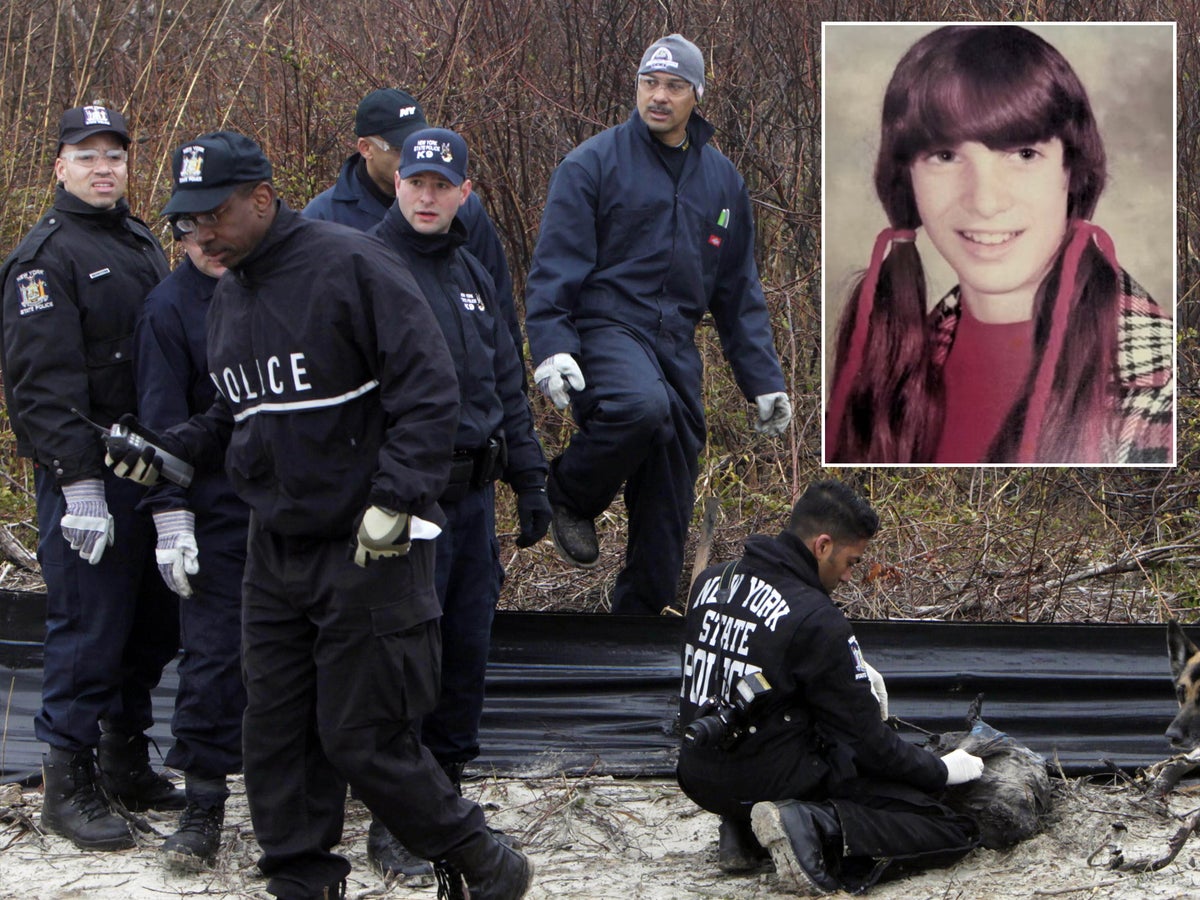
Gilgo Beach murders victim Karen Vergata made one final phone call to her father on the day that she was last seen alive, it has been revealed.
A petition filed in court in 2017 reveals that the 34-year-old woman called her father Dominic Vergata on his birthday on 14 February 1996. She was never seen or heard from again.
Long Island officials announced on Friday that Vergata went missing that very same day on Valentine’s Day 1996.
At the time, she was living on West 45th St in Manhattan and is believed to have been working as an escort.
Police said that no missing persons report was filed at the time.
But, court records show that in July 2017 – more than two decades later – Dominic Vergata filed a petition to have his daughter officially declared dead so that he could obtain the unclaimed assets from her estate, including two life insurance policies.
In the petition, Vergata’s father details that he last had contact with his daughter on 14 February 14 1996, when she called him on his birthday.
Before that, he said she would call him from time to time.
Following her disappearance, Dominic Vergata says that he tried to track down his missing daughter including hiring an investigator and contacting law enforcement agencies and people who had known her.
But those efforts were unfruitful as she had been murdered and her remains dumped in Long Island.
The Surrogate’s Court in New York ruled that, based on Vergata’s whereabouts being unknown for so long, she was presumed dead on 14 February 1999 and her father was appointed temporary administrator of her estate.
Records show Dominic Vergata died in December 2022.
It is unclear whether or not he knew what had happened to his daughter before he passed away.
On Friday, Long Island officials identified Vergata as the Gilgo Beach murders victim previously known only as Jane Doe 7 or Fire Island Jane Doe.
Karen Vergata was identified as Jane Doe 7— (Suffolk County DA)
Vergata’s partial remains were first discovered along the Long Island shores more than 26 years ago – but the victim’s identity remained unknown until now.
It was 20 April 1996 when a woman’s legs were found wrapped in plastic at Davis Park on Fire Island’s Blue Point Beach.
Almost exactly 15 years later on 11 April 2011, the woman’s skull was then found off Ocean Parkway during the search for Gilgo Beach victims. The skull was located close to the remains of another unidentified victim – Jane Doe 3, also known as Peaches.
The two sets of remains in Fire Island and Ocean Parkway were later found to belong to the same person.
Before now, investigators had long been unable to identify Jane Doe 7 and she was described only as a white woman aged 18 to 50 years old who had several notable scars including evidence of surgery on her left ankle.
She was one of 11 victims whose remains were found dumped along the shores of Gilgo Beach back in 2010 and 2011 – several of whom are also yet to be identified.
Decades later, investigators were finally able to identify Fire Island Jane Doe using genetic genealogy and her surviving relatives’ DNA.
In August 2022 – around six months after the new Gilgo Beach taskforce was launched – a DNA profile suitable for genealogical comparison was developed from the remains of the victim, officials said in a press conference on Friday.
The next month, the FBI was able to presumptively identify the victim using genetic genealogy as Vergata.
Then, that October, investigators tracked down a relative of Vergata and took a buccal swab. Using this, they were able to definitively identify the victim as Vergata.
While her identity was confirmed late last year, Suffolk County DA Rodney Tierney said in a press conference that officials kept the major breakthrough under wraps until now due to both the ongoing investigation into Mr Heuermann and the need to contact all of Vergata’s family members.
“Prior to disclosing, we needed to contact all Vergata’s family members and around the same time we were beginning the grand jury confidential investigation into the murders of the victims known as the Gilgo 4,” he told reporters.
”So we decided not to make it public... until the results of that investigation became public and we had made notice to Vergata’s family.”
Map showing sites where victims’ remains found along Gilgo Beach— (Suffolk County Police Department)
It remains unclear if Vergata’s father was the relative whose DNA was used to make the positive confirmation – or if he was told about his daughter’s fate before his death that December.
The huge breakthrough announcing Vergata’s identity came just weeks after suspected serial killer Rex Heuermann, a 59-year-old father-of-two architect, was arrested and charged with the murders of three of the Gilgo Beach victims.
In Friday’s press conference announcing Vergata’s identity, Suffolk County officials refused to confirm whether or not her murder may be linked to Mr Heuermann.
At this time, no one has been charged in connection to her homicide and her cause of death is unknown.
Mr Heuermann, a 59-year-old architect, was taken into custody on 13 July, almost 13 years after the bodies of at least 11 victims were discovered along the shores of Gilgo Beach on Long Island.
He was charged with the murders of Megan Waterman, Melissa Barthelemy and Amber Costello.
He is also the prime suspect in the murder of Maureen Brainard-Barnes – who was last seen alive in early June 2007 in New York City and who, with the three other women, is known as the “Gilgo Four”.
All four women worked as sex workers and disappeared after going to meet a client. They were all found in December 2010 within one-quarter mile of each other, bound by belts or tape and some wrapped in burlap – their bodies dumped along Gilgo Beach.
They are among 11 victims whose remains were found along the shores of Long Island in 2010 and 2011, sparking fears of one or more serial killers.
As well as looking into his connection to the murder of Brainard-Barnes and the other Gilgo Beach victims, law enforcement agencies are now also looking into unsolved murders and missing persons cases all across the country.
Police in Las Vegas and South Carolina – where Mr Heuermann owns properties – and Atlantic City – where several sex workers have been found murdered – have confirmed they are eyeing the suspect in cold cases.
Court records show that Mr Heuermann was linked to the “Gilgo Four” murders through a tip about his pickup truck, a stash of burner phones, “sadistic” online searches, phone calls taunting victims’ families, his wife’s hair found on the victims’ bodies – and a pizza crust.
The first piece of the puzzle came when a witness in the Amber Costello case revealed details about a vehicle that a client was driving when she was last seen alive.
Costello, who worked as a sex worker, was seen alive on the evening of 2 September 2010 when she left her home in West Babylon. A witness said she had gone to meet a client who was driving a first-generation Chevrolet Avalanche.
Last year, a registration search showed that local man Mr Heuermann owned a first-generation model of the truck at the time of Costello’s disappearance. He also matched the witness’ description of the man believed to be the killer: a large, white “ogre”-like male in his mid-40s, around 6’4’ to 6’6” tall, with “dark bushy hair,” and “big oval style 1970’s type eyeglasses”.
Rex Heuermann’s home being searched by investigators— (Copyright 2023 The Associated Press. All rights reserved.)
The discovery of the car led investigators to hone in on Mr Heuermann including executing 300 subpoenas, search warrants and other legal processes to obtain evidence to determine his potential involvement in the killings.
Among this was Mr Heuermann’s alleged use of burner phones, with prosecutors saying that he used burner phones to contact the three women and arrange to meet them at the time when they went missing.
He also allegedly took two of the victims’ cellphones – and used one to make taunting phone calls to one of their families where he boasted about her murder, court documents state.
Mr Heuermann’s DNA was found on one of the victims, while his wife’s hair was found on three of the four women he is connected to.
Following his arrest, his wife Asa Ellerup filed for divorce. She has since told The New York Post that she has been left filled with “anxiety” and their two children “cry themselves to sleep” over the horror.
“I woke up in the middle of the night, shivering... anxiety,” she said.
“My children cry themselves to sleep. I mean, they’re not children. They’re grown adults but they’re my children, and my son has developmental disabilities and he cried himself to sleep.”
Mr Heuermann’s sudden arrest comes after the horrific serial killer case has captured the nation’s attention for more than a decade.
The Gilgo Beach murders had long stumped law enforcement officials in Suffolk County who believed it could be the work of one or more serial killers who targeted sex workers and dumped their bodies along the remote beaches on Ocean Parkway.
The case began in May 2010 when Shannan Gilbert vanished after leaving a client’s house on foot near Gilgo Beach.
She called 911 for help saying she feared for her life and was never seen alive again.
Crime scene investigators use metal detectors to search a marsh for the remains of Shannan Gilbert in December 2011
During a search for Gilbert in dense thicket close to the beach, police discovered the remains of another woman.
Within a matter of days, the remains of three more victims were found close by.
By spring 2011, the remains of a total of 10 victims had been found including eight women, a man, and a toddler. Police have long thought that it could be the work of one or more serial killers.
Gilbert’s body was then found in December 2011. Her cause of death is widely contested with authorities long claiming that it is not connected to the serial killer or killers but that she died from accidental drowning as she fled from the client’s home.
However, an independent autopsy commissioned by her family ruled that she died by strangulation and her mother believes she was murdered.
Like Gilbert, most of the victims targeted were sex workers, while some are yet to be identified.







